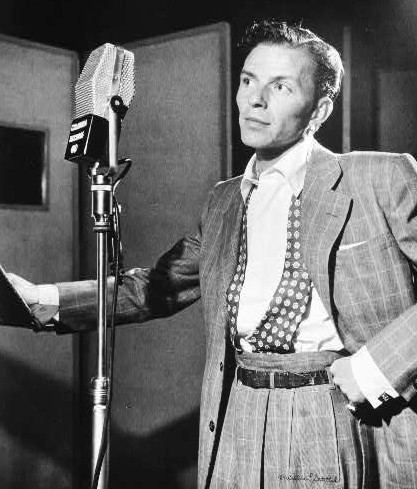 | ||
Crooner is an American epithet given to male singers of jazz standards, mostly from the Great American Songbook, backed by either a full orchestra, a big band or a piano. Originally it was an ironic term denoting a sentimental singing style made possible by the use of microphones. Some performers, such as Russ Columbo, did not accept the term: Frank Sinatra once said that he did not consider himself or Bing Crosby "crooners".
Contents
History
This dominant popular vocal style coincided with the advent of radio broadcasting and electrical recording. Before the advent of the microphone, popular singers like Al Jolson had to project to the rear seats of a theater, as did opera singers, which made for a very loud vocal style. The microphone made possible the more personal style. Al Bowlly, Gene Austin, Art Gillham and by some historical accounts, Vaughn De Leath are often credited as inventors of the crooning style but Rudy Vallée became far more popular, beginning from 1928. He could be heard by anyone with a phonograph or a radio.
"In his popular radio program, which began with his floating greeting, 'Heigh ho, everybody,' beamed in from a New York City night club, he stood like a statue, surrounded by clean-cut collegiate band musicians and cradling a saxophone in his arms."His first film, The Vagabond Lover, was promoted with the line, "Men Hate Him! Women Love Him!" while his success brought press warnings of the "Vallee Peril": this "punk from Maine" with the "dripping voice" required mounted police to beat back screaming, swooning females at his vaudeville shows.
By the early 1930s the term "crooner" had taken on a pejorative connotation, both Cardinal O'Connell of Boston and the New York Singing Teachers Association (NYSTA) publicly denouncing the vocal form, O'Connell calling it "base", "degenerate", "defiling" and un-American and NYSTA adding "corrupt". Even The New York Times predicted that crooning would be just a passing fad. The newspaper printed, "They sing like that because they can’t help it. Their style is begging to go out of fashion…. Crooners will soon go the way of tandem bicycles, mah jongg and midget golf." Voice range shifted from tenor (Vallée) to baritone (Russ Columbo, Bing Crosby). Still, a 1931 record by Dick Robinson, "Crosby, Columbo & Vallee", called upon men to fight "these public enemies" brought into homes via radio.
There were female crooners, including Annette Hanshaw, Mildred Bailey (at the beginning of her career) and Helen Rowland.
The genre enjoyed popularity within the former Soviet Union with Mark Reizen, Leonid Utyosov, Sergey Lemeshev, Ivan Kozlovsky, Pyotr Leshchenko, Pavel Lisitsian, Georg Ots, Oleg Anofriyev, Muslim Magomayev, and Joseph Kobzon leading the way. Their performances had a variety of influences including ballads and swing and was included in popular film soundtracks.
Decline
After 1954 popular music became dominated by other styles, especially rock 'n' roll, while the music of latter-day crooners such as Perry Como and Matt Monro was recategorized by radio stations as easy listening or adult contemporary. Crooners have remained popular among fans of traditional pop music, with contemporary performers such as Tony Bennett, Barry Manilow, Brian Evans, Richard Hawley, Harry Connick Jr., Michael Bublé, Neil Hannon, Peter Cincotti, Matteo Brancaleoni and Engelbert Humperdinck keeping the form alive. The term is rarely used to describe a female singer, although Mildred Bailey's pre-swing records as well as Helen Rowland are often considered part of the "crooning" style. Bing Crosby, Frank Sinatra, Dick Powell, Nat King Cole, Andy Williams, Bobby Darin and Jimmy Durante incorporated other popular styles into their music, such as blues, dixieland and even native Hawaiian music.
Country crooners
Due to the country songs popularized by Bing Crosby, the crooning style of singing became an enduring part of country music. Bing Crosby achieved a million seller with his 1940 rendition of the song " San Antonio Rose", originally recorded by Bob Wills & His Texas Playboys. In 1942 Perry Como had a smash hit with "Deep in the Heart of Texas"; Bing Crosby, who had an enormous influence on Perry Como, covered this song and took it to the #3 position in the US chart that same year. Eddy Arnold, Jim Reeves and Ray Price are especially well known for their country crooner standards. Dean Martin is rather famous for the country music he recorded in the period when he was working for Reprise Records. Fellow Italian-American crooner Perry Como recorded several albums with country producer Chet Atkins in Nashville. Regular, non-country crooners scored hits with pop versions of country-songs: Tony Bennett had a Billboard #1 hit in 1951 with his rendition of Hank Williams' "Cold, Cold Heart", which was also performed by Louis Armstrong; Perry Como had a Billboard #1 hit in 1953 with his version of "Don't Let the Stars Get in Your Eyes", a #1 country hit for its author Slim Willet and a #4 country hit for Ray Price; Guy Mitchell scored a Billboard #1 in 1959 with "Heartaches by the Number", a country-hit for Ray Price; Engelbert Humperdinck achieved a 1967 UK #1 hit with "Release Me", another song already made famous by Ray Price in 1954. In 1970 Ray Price had a #1 U.S. country hit and a #11 Billboard Hot 100 hit with the song "For the Good Times" written by Kris Kristofferson; subsequently Perry Como's rendition reached #7 in 1973 U.K. singles chart.
